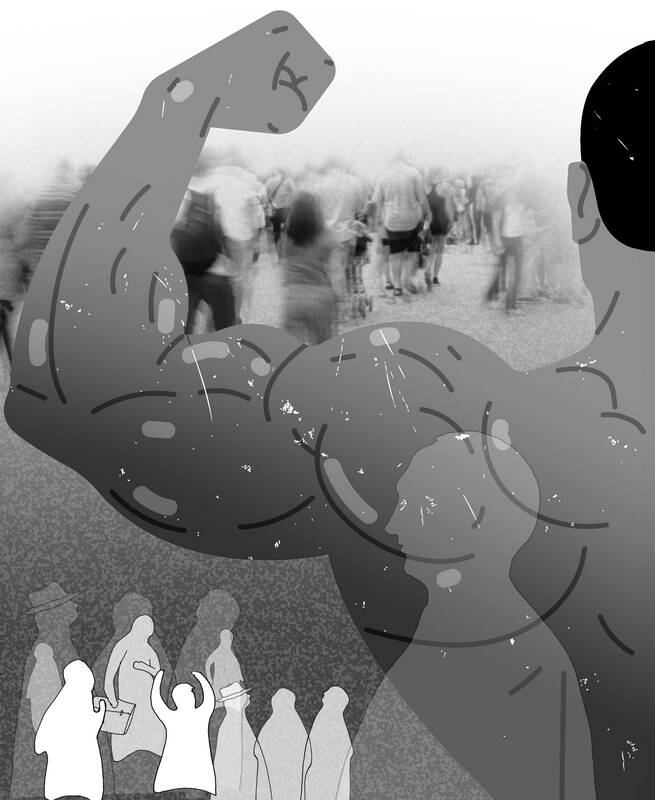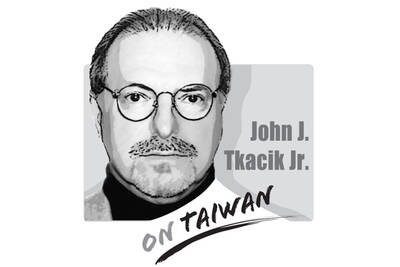Liberals have wasted no time in pointing to Karol Nawrocki’s lack of qualifications for his new job as president of Poland. He has never previously held political office. He won by the narrowest of margins, with 50.9 percent of the vote. However, Nawrocki possesses the one qualification that many national populists value above all other: a taste for physical strength laced with violence.
Nawrocki is a former boxer who still likes to go a few rounds. He is also such an enthusiastic soccer supporter that he reportedly got the logos of his two favorite teams — Chelsea and Lechia Gdansk — tattooed on his chest. During the campaign, he admitted to taking part in 2009 in a 70-a-side-punch-up with fans of rival clubs, alongside scores of convicted criminals armed with clubs and brass-knuckles. He denied other violence-related accusations, such as that he moonlighted as a pimp during a stint working as a security guard at a hotel and that he has extensive contacts with the Polish underworld. His come-from-behind campaign featured videos of the candidate in the boxing ring and shooting range, and a pledge to “make Poland great again.”
This emphasis on physical prowess laced with violence is commonplace on the nationalist right. The master of the genre is, of course, Russian President Vladimir Putin. Putin likes to pose doing macho things, such as hunting, shooting, fishing and ice-pool diving, often stripping down to his waist to reveal his rippling biceps and bare chest. He claims that he once stunned a Siberian tiger that was supposedly menacing a female journalist. In January 2007, Putin brought his black Labrador into a meeting with then-German chancellor Angela Merkel, a well-known canophobe, saying: “I’m sure it will behave.”

Illustration: Tania Chou
The mini-Putins in Russia’s sphere of influence cultivate the same macho style.
Chechen leader Ramzan Kadyrov frequently dresses in military garb and brandishes guns. He once kept a pet tiger, threatening to set it on journalists who wrote disobliging things about him. Belarusian President Alexander Lukashenko presents himself as a virile farmer, with his fluffy white dog giving him the air of a James Bond villain.
Indian President Narendra Modi boasts about his “56-inch chest” and claims that, as a boy, he went wild swimming among crocodiles. He also maintains a band of uniformed supporters, the Rashtriya Swayamsevak Sangh, who perform calisthenics dressed in skimpy shorts and march through the streets burning mosques.
Meanwhile, the Chinese propaganda machine claims that, during the Cultural Revolution, Chinese President Xi Jinping (習近平) regularly carried 100kg of wheat over three miles without switching shoulders, and likens his long ascent to power to “the training of a kung fu master.”
Turkish President Recep Tayyip Erdogan once christened the opening of a new stadium in Istanbul by playing himself and scoring a hat trick — all on live TV.
US President Donald Trump is such a devoted wrestling fan that the World Wrestling Entertainment has made him a “hall of famer.” He loves a physical display of power: He has been agitating for a military parade in Washington since first coming to power. His solutions to the problem of illegal immigrants during his first term included shooting to kill, shooting in the kneecaps, roasting with heat rays or digging a moat and filling it with alligators. He proudly hung a portrait of himself in his Mar-a-Lago estate fashioned out of bullet casings — a present from the self-declared “Trump of the tropics,” former Brazilian president Jair Bolsonaro.
Trump’s infatuation with Putin is the subject of all sorts of conspiracy theories. However, the simplest explanation is that Putin is the world’s leading exemplar of the quality Trump most admires. Other members of the strongmen club fascinated him for the same reason. He nicknamed Erdogan “the Sultan,” and told everybody how much he admired his “seemingly endless ability to get his own way at home.” He was much impressed by the fact that North Korean leader Kim Jong-un’s bodyguards ran alongside his limousine.
US Secretary of Homeland Security Kristi Noem endorsed Nawrocki’s candidacy on May 27, saying: “Donald Trump is a strong leader for us, but you have the opportunity to have just as strong a leader in Karol.”
The right’s cult of physical strength is not incidental. It is a metaphor for a much broader argument: That liberalism is synonymous with weakness and that the only way to escape from such weakness is to embrace headstrong, authoritarian leaders. Liberalism’s preoccupation with rules and consensus leads to paralysis and its concern for society’s casualties leads to self-paralysis, the argument says. Therefore, what the world needs, especially in periods of uncertainty, are strong leaders who can cut through the nonsense and uphold their nation’s traditions.
This cult of strength helps to explain the growing support for right-wing parties among young men. Trump won young men (aged 18 to 29) by 14 points, while former US vice president Kamala Harris, his rival, won young women by 18 points. The UK’s Reform Party and Germany’s Alternative for Germany also do well among young men. It also helps to explain the right’s broader appeal to people who are fed up with political paralysis. Across the world, right-wing parties demonize the bureaucratic blob that protects the status quo and human rights lawyers who make it difficult to stem the flow of refugees.
This obsession with strength also dictates the right’s governing style. Everywhere they gain power, national populists underming independent institutions and gather power to the executive — most obviously in countries with weak or non-existent democratic traditions such as Russia, but also in the West. Trump is systematically weakening the “checks and balances” that were supposed to limit the president’s power, including the courts, the civil service, the press and the congress. He likes to assure friendly audiences that “I have the right to do whatever I want as president,” quoting Napoleon by saying “he who saves his country does not violate the law.”
Yet the equation of liberalism with weakness and autocracy with strength is a serious error. The liberal order stood up to the threat of communism after World War II through a combination of internal consensus building and external relentlessness. Authoritarian rule tends to be marred by faction fighting and brittleness, making democracies far more durable than strongmen regimes.
This is an error that could have rapid consequences in Poland. The country has been a model of strength under centrist rule, with an annual average growth of 4 percent and the largest army in Europe after Russia, Ukraine and Turkey. The election of a supposed strongman to the presidency would inevitably make Poland weaker.
Adrian Wooldridge is the global business columnist for Bloomberg Opinion. A former writer at the Economist, he is author of The Aristocracy of Talent: How Meritocracy Made the Modern World.
A 50-year-old on Wednesday last week died while under anesthesia at a Taipei cosmetic clinic shortly after undergoing a penis enlargement procedure. The surgeon was arrested for suspected medical malpractice, again bringing to the surface shortcomings in the regulation of cosmetic medicine. Media reports said the clinic owner and surgeon, surnamed Ting (丁), was previously convicted of negligent homicide for a postsurgical death and had been charged with coercion and aggravated assault after allegedly stopping a patient from calling for an ambulance. He had also been fined for failing inspections and had allegedly permitted people without medical licenses to assist
The Chinese Communist Party (CCP) will stop at nothing to weaken Taiwan’s sovereignty, going as far as to create complete falsehoods. That the People’s Republic of China (PRC) has never ruled Taiwan is an objective fact. To refute this, Beijing has tried to assert “jurisdiction” over Taiwan, pointing to its military exercises around the nation as “proof.” That is an outright lie: If the PRC had jurisdiction over Taiwan, it could simply have issued decrees. Instead, it needs to perform a show of force around the nation to demonstrate its fantasy. Its actions prove the exact opposite of its assertions. A

It was most annoying last week to read Chairman Xi Jinping’s (習近平) fulsome encomium to the People’s Liberation Army during the Eightieth Anniversary celebrations of victory over Japan in World War II. Comrade Xi’s soaring rhetoric was stuffed with “martyrs, sacrifice, solemnity and unwavering resolve” in praise of the “Chinese People’s War of Resistance Against Japanese Aggression and the World Anti-Fascist War.” His aspirations overflowed with “world peace” and love of the United Nations, of which China is a founding member. The Liberation Army Daily said that every word from General Secretary Xi Jinping “resounded in his powerful voice, illuminating the
An American Institute in Taiwan (AIT) spokesperson on Saturday rebuked a Chinese official for mischaracterizing World War II-era agreements as proving that Taiwan was ceded to China. The US Department of State later affirmed that the AIT remarks reflect Washington’s long-standing position: Taiwan’s political status remains undetermined and should only be resolved peacefully. The US would continue supporting Taiwan against military, economic, legal and diplomatic pressure from China, and opposes any unilateral attempt to alter the “status quo,” particularly through coercion or force, the United Daily News cited the department as saying. The remarks followed Chinese Minister of Foreign Affairs